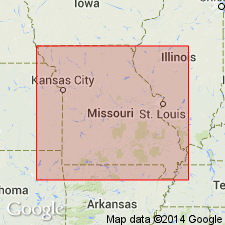
- Usage in publication:
-
- Silver Mine granite
- Modifications:
-
- First used
- Dominant lithology:
-
- Granite
- AAPG geologic province:
-
- Midcontinent region
Summary:
First used to describe medium-grained, red granite occurring along southern border of main mass of granite in portions of Iron Mountain and Mine La Motte quads, in area of St. Francois Mountains, southeast MO, Midcontinent region. Unit is characterized by its heavy mineral assemblage and by presence of northeast striking dikes. Granite was intruded after intrusion of diabase at Skrainka, Tin Mountain and in Edgehill quad; intruded before intrusion of basic dikes in Iron Mountain and Mine La Motte quads. Pre-Cambrian age.
Source: GNU records (USGS DDS-6; Denver GNULEX).
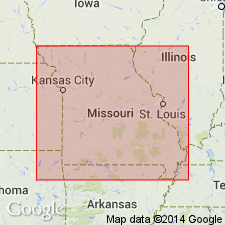
- Usage in publication:
-
- Silvermine Granite
- Modifications:
-
- Geochronologic dating
- AAPG geologic province:
-
- Midcontinent region
Summary:
Isotopic evidence [method not specified] suggests that Silvermine and Butler Hill granites are 1400-1450 m.y. old. Study area is in St. Francois Mountains, southeast MO, Midcontinent region.
Source: GNU records (USGS DDS-6; Denver GNULEX).
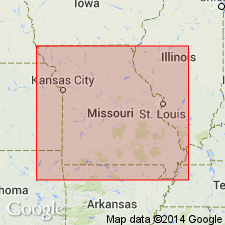
- Usage in publication:
-
- Silvermine granite
- Modifications:
-
- Principal reference
- Dominant lithology:
-
- Granite
- AAPG geologic province:
-
- Midcontinent region
Summary:
Pg. 47. Silvermine granite of Bevos group. A medium-grained granite, usually porphyritic, mottled gray and buff to mottled gray and red. Contains light gray to buff plagioclase, pink potash feldspar, quartz, and small indistinct clusters of biotite and hornblende. Is cut by quartz veins. In vicinity of Silver Mine, veins have yielded tungsten and minor amounts of silver and lead. Unit formed during later phase (of 2) of batholithic intrusion. Represents deepest zone in differentiation of batholith and appears to have differentiated in place. Together with Knoblick and Slabtown granites comprise a complex ring structure. Outcrops confined to southern part of exposed batholith of St. Francois Mountains, southeastern Missouri. Appears to grade into overlying Butler Hill granite of Bevos group to the northeast and Breadtray granite of Bevos group to the northwest. Age is Precambrian.
Type area: near Silver Mine, in sec. 10, T. 33 N., R. 5 E., Madison Co., southeastern MO.
See C.E. Robertson, 1995, Precambrian rocks, IN T.L. Thompson, Stratigraphic succession in Missouri (revised-1995), Missouri Division of Geology and Land Survey, 2nd series, v. 40 Revised, p. 5-14.
Source: Strat. succession in Missouri (Thompson, 1995, p. 12); GNU records (USGS DDS-6; Denver GNULEX).
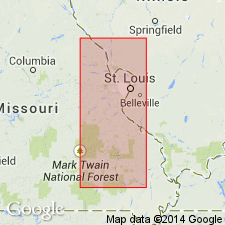
- Usage in publication:
-
- Silvermine Granite
- Modifications:
-
- Geochronologic dating
- AAPG geologic province:
-
- Midcontinent region
Summary:
U-Pb age of 1495 +/-20 m.y. determined on zircon; no Rb-Sr age determined. Samples are from St. Francois Mountains, southeast MO, Midcontinent region.
Source: GNU records (USGS DDS-6; Denver GNULEX).
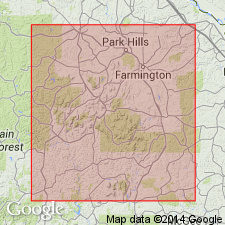
- Usage in publication:
-
- Silvermine Granite
- Modifications:
-
- Geochronologic dating
- AAPG geologic province:
-
- Midcontinent region
Summary:
U-Pb age on zircons determined to be 1501 +/-40 m.y. Rb-Sr data on whole-rock samples and mineral separates did not yield reliable age dates. Samples taken in T33N, R6E, Madison Co, MO, Midcontinent region (specific localities listed in appendix 3). Analytical data in appendices 2 and 4.
Source: GNU records (USGS DDS-6; Denver GNULEX).
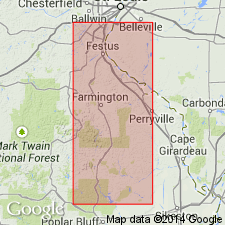
- Usage in publication:
-
- Silvermine Granite
- Modifications:
-
- Geochronologic dating
- AAPG geologic province:
-
- Midcontinent region
Summary:
Zircon U-Pb age of 1501 +/-40 m.y. on Silvermine in St. Francois Mountains, MO, Midcontinent region.
Source: GNU records (USGS DDS-6; Denver GNULEX).
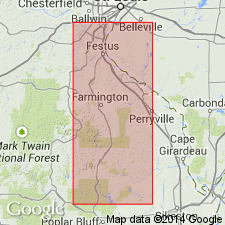
- Usage in publication:
-
- Silvermine Granite
- Modifications:
-
- Revised
- AAPG geologic province:
-
- Midcontinent region
Summary:
Silvermine Granite (referred to in table 1 as "Silvermine-Knoblick Granites"), one of seven Precambrian Y plutonic rock units assigned to the /St. Francois Mountains Intrusive Suite (revised). [Previously assigned to Bevos Group by Tolman and Robertson (1969); status of Bevos not discussed.] Present in St. Francois Mountains, southeast Missouri (Midcontinent region). Younger than "Slabtown-Stono Granites" (revised) of St. Francois Mountains; older than Graniteville Granite (revised) of St. Francois Mountains. Age is Precambrian Y. Nomenclature listed in table 1.
[Conflicts with nomenclature guidelines (ACSN, 1970; NACSN, 1983, 2005, 2021): name St. Francois Mountains applied concurrently to two different units in same area.]
Source: Modified from GNU records (USGS DDS-6; Denver GNULEX).
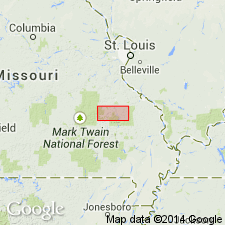
- Usage in publication:
-
- Silvermine granite
- Modifications:
-
- Overview
- AAPG geologic province:
-
- Midcontinent region
Summary:
Mapped in central St. Francois Mountains, southeast MO, Midcontinent region. [Not clear if authors intended stratigraphic units within study area to be formal or informal.] Exposures extend about 4 km north-south and 8 km east-west which are most extensive exposures of any of low-silica plutons (which are mapped undivided as "Ring Plutons of Butler Hill Caldera" and include Stono, Silvermine, Slabtown, and Knoblick Granites of Tolman and Robertson, 1969). Consists of medium-grained granite which is most abundant type in outcrop and fine-grained porphyritic type which caps cliffs along St. Francis River and represents roof facies. Nonconformably overlain by Lamotte sandstone to northeast. Low-silica plutons occur around margin of larger, high-silica Butler Hill granite (revised); contacts are not well enough exposed to determine intrusive relationships except that Butler Hill is intruded by Silvermine. Shown on map explanation to be younger than "Butler Hill-Breadtray Granite" map unit; older than "Hypabyssal Intrusives of Western St. Francois Mountains" map unit (which includes Munger Granite Porphyry and Carver Creek Granite of Tolman and Robertson, 1969). Everywhere that contacts are observed, plutonic rocks are younger than, and intrude, volcanic rocks of St. Francois Mountains. Proterozoic age.
[Authors' intentions are unclear as to which, if any, of the geologic units discussed should have formal status.]
Source: GNU records (USGS DDS-6; Denver GNULEX).
For more information, please contact Nancy Stamm, Geologic Names Committee Secretary.
Asterisk (*) indicates published by U.S. Geological Survey authors.
"No current usage" (†) implies that a name has been abandoned or has fallen into disuse. Former usage and, if known, replacement name given in parentheses ( ).
Slash (/) indicates name conflicts with nomenclatural guidelines (CSN, 1933; ACSN, 1961, 1970; NACSN, 1983, 2005, 2021). May be explained within brackets ([ ]).

